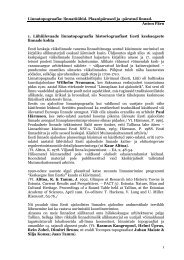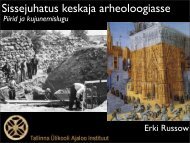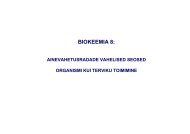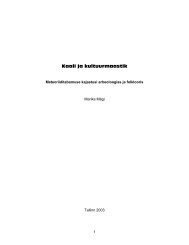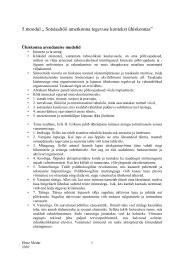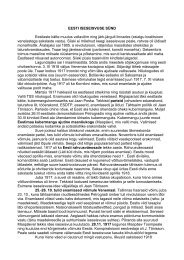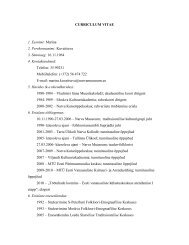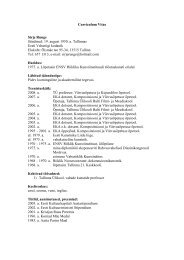Guidance theory and practice: the status of career exploration
Guidance theory and practice: the status of career exploration
Guidance theory and practice: the status of career exploration
Create successful ePaper yourself
Turn your PDF publications into a flip-book with our unique Google optimized e-Paper software.
British Journal <strong>of</strong> <strong>Guidance</strong> & Counselling,<br />
Vol. 31, No. 2, May 2003<br />
<strong>Guidance</strong> <strong><strong>the</strong>ory</strong> <strong>and</strong> <strong>practice</strong>: <strong>the</strong><br />
<strong>status</strong> <strong>of</strong> <strong>career</strong> <strong>exploration</strong><br />
MARIA DO CEU TAVEIRA<br />
Department <strong>of</strong> Psychology, University <strong>of</strong> Minho, Campus Gualtar, 4700 Braga, Portugal<br />
M. LUISA RODRÍGUEZ MORENO<br />
Departament de Mètodes d’Investigació i Diagnòstic en Educació, Universitat de<br />
Barcelona, Passeig de la Vall Hebron 171, Barcelona 08035, Spain<br />
ABSTRACT Career intervention can be designed to enhance constructive attitudes, emotions <strong>and</strong><br />
behaviours that will improve clients’ <strong>career</strong> attainment. In this sense, mobilisation <strong>of</strong> <strong>career</strong><br />
<strong>exploration</strong> constitutes one <strong>of</strong> <strong>the</strong> most important tasks <strong>of</strong> <strong>career</strong> counsellors, particularly with<br />
emphasis in developmental <strong>career</strong> guidance models, first developed in <strong>the</strong> 1950s. The authors present a<br />
brief review <strong>of</strong> <strong>career</strong> <strong>exploration</strong> conceptualisation <strong>and</strong> empirical research lines. The implications for<br />
<strong>career</strong> guidance <strong>and</strong> counselling are addressed.<br />
Recently, a renewed interest in <strong>career</strong> <strong>exploration</strong> has emerged in <strong>the</strong> <strong>career</strong><br />
development literature. Career <strong>exploration</strong> refers to those purposeful activities,<br />
directed toward enhancing self- <strong>and</strong> environment consciousness <strong>and</strong> knowledge, that<br />
individuals engage in to foster progress in <strong>career</strong> development (e.g. Jordaan, 1963).<br />
During <strong>the</strong> last three decades, several researchers have focused on <strong>the</strong> nature <strong>and</strong><br />
contexts <strong>of</strong> <strong>career</strong> <strong>exploration</strong>, encouraging <strong>career</strong> development pr<strong>of</strong>essionals to<br />
increase <strong>the</strong>ir underst<strong>and</strong>ing <strong>of</strong> <strong>the</strong> <strong>career</strong> <strong>exploration</strong> process across <strong>the</strong> life-span<br />
<strong>and</strong> for diverse populations (Luzzo & McGregor, 2001). The purpose <strong>of</strong> this article<br />
is to briefly review <strong>the</strong> conceptualisations <strong>of</strong> <strong>the</strong> <strong>career</strong> <strong>exploration</strong> process <strong>and</strong><br />
related research <strong>and</strong> to suggest ways to apply <strong>career</strong> <strong>exploration</strong> <strong><strong>the</strong>ory</strong> <strong>and</strong> research<br />
to <strong>career</strong> guidance <strong>and</strong> counselling.<br />
Career <strong>exploration</strong>: <strong><strong>the</strong>ory</strong> <strong>and</strong> <strong>practice</strong><br />
The <strong><strong>the</strong>ory</strong> <strong>of</strong> <strong>career</strong> <strong>exploration</strong> was developed only in <strong>the</strong> early 1960s, when it first<br />
started being considered as a category <strong>of</strong> general exploratory behaviour (Jordaan,<br />
E-mail: ceuta@mail.telepac.pt<br />
ISSN 0306-9885/print/ISSN 1469-3534/online/03/020189-19 # 2003 Careers Research <strong>and</strong> Advisory Centre<br />
DOI: 10.1080/0306988031000102360
190 Maria do Ceu Taveira & M. Luisa Rodríguez Moreno<br />
1963). Recent reviews <strong>of</strong> <strong>the</strong> topic by Taveira (1997, 2001) identify four different<br />
conceptions <strong>of</strong> <strong>career</strong> <strong>exploration</strong>, which clearly illustrate <strong>the</strong> evolution <strong>of</strong> <strong>the</strong><br />
construct during <strong>the</strong> last century, <strong>and</strong> can now be viewed as complementary to one<br />
ano<strong>the</strong>r.<br />
The first <strong>and</strong> more simplistic concept, which originated in <strong>the</strong>ories such as<br />
Krumboltz’s learning <strong><strong>the</strong>ory</strong> <strong>of</strong> <strong>career</strong> choice <strong>and</strong> counselling (Krumboltz, 1979),<br />
considers <strong>career</strong> <strong>exploration</strong> as a type <strong>of</strong> information-seeking behaviour or as a <strong>career</strong><br />
problem-solving behaviour. A second concept, derived from <strong>career</strong> decision <strong><strong>the</strong>ory</strong>,<br />
considers <strong>career</strong> <strong>exploration</strong> as an important phase in <strong>the</strong> process <strong>of</strong> <strong>career</strong> decisionmaking,<br />
involving <strong>the</strong> identification <strong>and</strong> evaluation <strong>of</strong> options <strong>and</strong> informationseeking<br />
behaviour (e.g. Gelatt, 1962; Tiedeman & O’Hara, 1963). A third concept,<br />
with origins in normative <strong>career</strong> development <strong>the</strong>ories, defines <strong>exploration</strong> as a major<br />
life stage, that <strong>of</strong> adolescence (from ages 14 to 24), <strong>and</strong> comprising <strong>the</strong> <strong>career</strong><br />
developmental tasks <strong>of</strong> crystallising, specifying <strong>and</strong> implementing an occupational<br />
choice (Ginzberg et al., 1951; Super, 1957). The fourth <strong>and</strong> final concept is a recent<br />
position that describes <strong>exploration</strong> as a life-span process underlying <strong>career</strong> learning<br />
<strong>and</strong> development (Atkinson & Murrell, 1988; Blustein, 1997; Jordaan, 1963; Super,<br />
1995; Taveira, 1997).<br />
Consistent with this last position, <strong>career</strong> <strong>exploration</strong> has been referred to as a<br />
complex psychological process, which sustains <strong>the</strong> search <strong>of</strong> information, as well as<br />
hypo<strong>the</strong>sis testing about self <strong>and</strong> environment, in order to attain <strong>career</strong> goals. It<br />
involves both cognitive <strong>and</strong> affective activities <strong>of</strong> interpreting <strong>and</strong> recreating past <strong>and</strong><br />
present experiences <strong>and</strong>, moved by intrinsic or instrumental motives, <strong>of</strong> projecting<br />
<strong>the</strong>m into <strong>the</strong> future. In addition, according to <strong>the</strong> processual view <strong>of</strong> <strong>the</strong> construct,<br />
self- <strong>and</strong> environment <strong>exploration</strong> are conceived as two dimensions <strong>of</strong> <strong>the</strong> same<br />
process, that <strong>of</strong> <strong>career</strong> <strong>exploration</strong>, ra<strong>the</strong>r than as two distinct exploratory processes.<br />
Fur<strong>the</strong>rmore, it is assumed that what best distinguishes <strong>career</strong> <strong>exploration</strong> from<br />
general <strong>exploration</strong> is <strong>the</strong> nature <strong>of</strong> exploratory activity goals, <strong>and</strong> not <strong>the</strong> process or<br />
context <strong>of</strong> that activity. In short, <strong>the</strong> mere presence <strong>of</strong> information-seeking behaviour<br />
or <strong>of</strong> self-appraisal does not in itself guarantee that we are in <strong>the</strong> presence <strong>of</strong> a <strong>career</strong><br />
<strong>exploration</strong> process. Ra<strong>the</strong>r, <strong>career</strong> <strong>exploration</strong> requires <strong>career</strong>-goal-orientated<br />
behaviour.<br />
Jordaan (1963) is a key figure in <strong>the</strong> <strong>the</strong>orisation <strong>of</strong> <strong>career</strong> <strong>exploration</strong>. He <strong>and</strong><br />
his team initiated a line <strong>of</strong> work which has had <strong>and</strong> continues to have a tremendous<br />
impact upon <strong>career</strong> <strong>exploration</strong> thinking <strong>and</strong> research, even outside vocational<br />
psychology (e.g. Grotevant & Cooper, 1988; Kracke, 1997). Throughout <strong>the</strong> 1970s<br />
<strong>and</strong> 1980s, Stumpf et al. (1983) <strong>and</strong> Blustein (1987, 1988, 1989a,b), among o<strong>the</strong>rs,<br />
largely operationalised <strong>the</strong> construct <strong>of</strong> <strong>career</strong> <strong>exploration</strong> for research purposes.<br />
Subsequently, <strong>and</strong> as a consequence <strong>of</strong> a more in-depth approach to <strong>the</strong> topic, two<br />
related main lines <strong>of</strong> research have been encountered in <strong>the</strong> domain: (a) <strong>the</strong><br />
development <strong>and</strong> validation <strong>of</strong> <strong>career</strong> <strong>exploration</strong> assessment devices, <strong>and</strong> (b) <strong>the</strong><br />
study <strong>of</strong> <strong>the</strong> conditions <strong>and</strong> results <strong>of</strong> <strong>career</strong> <strong>exploration</strong>. The following sections<br />
briefly review each <strong>of</strong> <strong>the</strong>se lines <strong>of</strong> work.
<strong>Guidance</strong> <strong><strong>the</strong>ory</strong> <strong>and</strong> <strong>practice</strong> 191<br />
The development <strong>and</strong> validation <strong>of</strong> <strong>career</strong> <strong>exploration</strong> assessment devices<br />
During <strong>the</strong> last two decades, several methods <strong>and</strong> instruments for <strong>the</strong> assessment <strong>of</strong><br />
<strong>career</strong> <strong>exploration</strong> have been developed, according to <strong>the</strong> different conceptions <strong>of</strong> <strong>the</strong><br />
construct. Some very well-known assessment devices st<strong>and</strong> out, such as structured<br />
interviews <strong>and</strong> questionnaires, checklists, vocational maturity inventories, <strong>and</strong> <strong>the</strong><br />
direct observation <strong>of</strong> <strong>career</strong> information-seeking behaviour, ei<strong>the</strong>r in real or<br />
simulated situations (Blustein, 1990). More recently, occupational card sort has<br />
been suggested as an additional <strong>career</strong> <strong>exploration</strong> assessment procedure (Peterson,<br />
1998; Petterson & Lenz, 1992), permitting <strong>the</strong> analysis <strong>of</strong> individual integration <strong>of</strong><br />
occupational knowledge.<br />
Amongst <strong>the</strong> most significant measures is <strong>the</strong> Career Exploration Survey (CES)<br />
by Stumpf et al. (1983), which operationalises a complex hierarchical model <strong>of</strong> <strong>the</strong><br />
<strong>career</strong> <strong>exploration</strong> process, including cognitive, behavioural <strong>and</strong> affective dimensions<br />
<strong>of</strong> <strong>the</strong> construct.<br />
The CES is a self-administered scale <strong>of</strong> 62 items using Likert-type response<br />
format, designed to assess six beliefs about <strong>exploration</strong> (employment outlook,<br />
certainty <strong>of</strong> <strong>career</strong> <strong>exploration</strong> outcomes, external search instrumentality, internal<br />
search instrumentality, method search instrumentality <strong>and</strong> importance <strong>of</strong> preferred<br />
position), seven dimensions <strong>of</strong> <strong>the</strong> <strong>exploration</strong> process (extent <strong>of</strong> environment <strong>and</strong><br />
<strong>of</strong> self-<strong>exploration</strong>, intended-systematic <strong>exploration</strong>, frequency, amount <strong>of</strong> information<br />
acquired, number <strong>of</strong> options considered <strong>and</strong> focus <strong>of</strong> <strong>exploration</strong>) <strong>and</strong> three<br />
reactions to <strong>exploration</strong> (satisfaction with information, <strong>exploration</strong> stress <strong>and</strong><br />
decision stress). The questionnaire was initially developed for young adults <strong>and</strong><br />
was later adapted for adolescents by Blustein (1988). A new version <strong>of</strong> <strong>the</strong> CES<br />
was adapted for Portugal by Taveira (1997). The dimensionality <strong>and</strong> structure <strong>of</strong><br />
<strong>the</strong> CES was tested in a confirmatory factor analysis <strong>and</strong> different pr<strong>of</strong>iles <strong>of</strong><br />
<strong>career</strong> <strong>exploration</strong> were identified among Portuguese adolescents (Taveira et al.,<br />
1998). After that, <strong>the</strong> CES was adapted in Spain by Rodríguez-Moreno et al.<br />
(2000), who developed a criterion-based system to categorise scale results.<br />
Fur<strong>the</strong>rmore, to enable <strong>the</strong> development <strong>of</strong> <strong>career</strong> <strong>exploration</strong> studies with socially<br />
excluded groups <strong>the</strong>se same authors adapted <strong>the</strong> content <strong>of</strong> <strong>the</strong> CES scales to that<br />
population.<br />
Although <strong>the</strong> increased efforts to assess <strong>career</strong> <strong>exploration</strong> are evidence <strong>of</strong> a<br />
renewal <strong>of</strong> interest in <strong>the</strong> process, much work has yet to be done regarding <strong>the</strong><br />
dimensionality <strong>and</strong> structure <strong>of</strong> this vocational construct. In <strong>the</strong> past few years, much<br />
<strong>of</strong> <strong>the</strong> available research has used revised versions <strong>of</strong> <strong>the</strong> Career Exploration Survey.<br />
Never<strong>the</strong>less, most studies are restrictive, adopting a simplistic operational definition<br />
<strong>of</strong> <strong>the</strong> <strong>career</strong> <strong>exploration</strong> process through <strong>the</strong> exclusive use <strong>of</strong> <strong>the</strong> self- <strong>and</strong><br />
environment <strong>exploration</strong> scales <strong>of</strong> <strong>the</strong> CES: that is, assessing only <strong>the</strong> extent <strong>of</strong><br />
self- <strong>and</strong> environment <strong>exploration</strong>. Future research <strong>and</strong> discussion on <strong>the</strong> dimensionality<br />
<strong>and</strong> structure would constitute an important development <strong>of</strong> <strong>career</strong><br />
<strong>exploration</strong> assessment.
192 Maria do Ceu Taveira & M. Luisa Rodríguez Moreno<br />
The study <strong>of</strong> <strong>career</strong> <strong>exploration</strong> process <strong>and</strong> outcomes<br />
The second main line <strong>of</strong> research involves <strong>the</strong> study <strong>of</strong> <strong>career</strong> <strong>exploration</strong> process <strong>and</strong><br />
outcomes. One line <strong>of</strong> inquiry focuses on <strong>the</strong> contextual <strong>and</strong> personal conditions <strong>of</strong><br />
<strong>career</strong> <strong>exploration</strong>, which have been studied over <strong>the</strong> past three decades under a<br />
broad range <strong>of</strong> perspectives. The first studies were developed under <strong>the</strong> social<br />
learning paradigm <strong>and</strong> indicate that vicarious reinforcement <strong>and</strong> modelling have a<br />
positive impact on <strong>the</strong> amount <strong>and</strong> frequency <strong>of</strong> <strong>career</strong> exploratory behaviour (e.g.<br />
Krumboltz & Schroeder, 1965). O<strong>the</strong>r studies indicate that this impact is also a<br />
function <strong>of</strong> individual personality <strong>and</strong> developmental stage (Aiken & Johnston, 1973;<br />
Hosie, 1975; Lazarick et al., 1988), highlighting <strong>the</strong> role <strong>of</strong> external reinforcement in<br />
<strong>the</strong> qualitative aspects <strong>of</strong> <strong>exploration</strong>.<br />
In this context, most <strong>of</strong> <strong>the</strong> studies that consider implicitly or explicitly <strong>the</strong><br />
contributions <strong>of</strong> motivation <strong><strong>the</strong>ory</strong> have produced interesting findings about <strong>the</strong><br />
variance <strong>of</strong> <strong>career</strong> <strong>exploration</strong> explained by personal variables. A first group <strong>of</strong><br />
studies, based on expectancy-value <strong>the</strong>ories, suggest that activation <strong>of</strong> <strong>career</strong><br />
<strong>exploration</strong> is associated with work role salience, <strong>the</strong> importance <strong>of</strong> preferred <strong>career</strong><br />
domain, attainment <strong>of</strong> valued <strong>career</strong> goals, decision satisfaction <strong>and</strong> instrumentality<br />
<strong>of</strong> <strong>career</strong> <strong>exploration</strong> (see Blustein & Flum, 1999; Flum & Blustein, 1999, 2000;<br />
Taveira, 2001). To summarise, <strong>the</strong>re is evidence to conclude that <strong>career</strong> <strong>exploration</strong><br />
is influenced by <strong>the</strong> importance attached to <strong>the</strong> <strong>career</strong> development domain <strong>and</strong> by<br />
<strong>the</strong> satisfaction with <strong>career</strong> results <strong>and</strong> <strong>the</strong> consequent effect on outcome expectations.<br />
The studies based on <strong>the</strong>ories <strong>of</strong> motivation such as self-determination <strong><strong>the</strong>ory</strong><br />
by Deci <strong>and</strong> Ryan (1985) also suggest that some <strong>career</strong> <strong>exploration</strong> may be selfdetermined<br />
(Blustein, 1988), which means that it can be ei<strong>the</strong>r intrinsically<br />
motivated or motivated through <strong>the</strong> internalisation <strong>of</strong> extrinsic regulations. In fact,<br />
some empirical evidence suggests that feelings <strong>of</strong> self-determination, perceived<br />
competence, internal locus <strong>of</strong> control, self-efficacy expectations, self-esteem <strong>and</strong><br />
moderate levels <strong>of</strong> stress are related to <strong>career</strong> <strong>exploration</strong> intentions <strong>and</strong>/or activation<br />
(e.g. Betz & Voyten, 1997; Blustein, 1988, 1989a; Solberg, 1998; Taylor & Pompa,<br />
1990).<br />
Overall <strong>the</strong>se results indicate that external incentives to <strong>career</strong> <strong>exploration</strong> may<br />
not always be beneficial, <strong>and</strong> that psychological confidence, self-direction, <strong>and</strong> o<strong>the</strong>r<br />
positive feelings about <strong>the</strong> self <strong>and</strong> <strong>the</strong> context, as well as some sense <strong>of</strong> imminence<br />
regarding <strong>career</strong> development tasks, increase <strong>the</strong> probability <strong>of</strong> <strong>career</strong> <strong>exploration</strong><br />
involvement by individuals.<br />
Despite <strong>the</strong> empirical evidence suggesting that <strong>career</strong> <strong>exploration</strong> may be selfdetermined,<br />
<strong>the</strong> case <strong>of</strong> those adolescents <strong>and</strong> adults who are not interested in <strong>career</strong><br />
<strong>exploration</strong> or who <strong>of</strong>fer resistance to extensive self- or environment <strong>exploration</strong><br />
deserves fur<strong>the</strong>r attention. For instance, attachment <strong><strong>the</strong>ory</strong> <strong>and</strong> research suggest that<br />
individuals who grow up in familial environments that favour insecure attachment<br />
representations do not get actively involved in <strong>exploration</strong> <strong>and</strong> may exhibit high levels<br />
<strong>of</strong> anxiety in this type <strong>of</strong> activity (see Soares, 1992, 1996). On <strong>the</strong> o<strong>the</strong>r h<strong>and</strong>,<br />
research inspired by <strong>the</strong> identity <strong>status</strong> paradigm formulated by Marcia (1966)<br />
suggests that ‘foreclosure’, one <strong>of</strong> <strong>the</strong> four identified <strong>status</strong>es <strong>of</strong> identity, characterises
<strong>Guidance</strong> <strong><strong>the</strong>ory</strong> <strong>and</strong> <strong>practice</strong> 193<br />
those adolescents who ‘remain closely tied to <strong>the</strong>ir families, with guilt <strong>and</strong> anxiety<br />
attendant to questioning parental values. Thus to invite a foreclosure to explore, ‘is to<br />
ask him or her to do <strong>and</strong> be <strong>the</strong> opposite <strong>of</strong> what he or she learned under anxietyarousing<br />
conditions to not do <strong>and</strong> not be’ (Marcia, 1994, p. 39). Fur<strong>the</strong>rmore,<br />
diffusion, ano<strong>the</strong>r identity <strong>status</strong>, ‘characterises adolescents who lack firm commitments<br />
<strong>and</strong> who are not currently in <strong>the</strong> process <strong>of</strong> active self-<strong>exploration</strong>’ (Berzonsky,<br />
2000, p. 21).<br />
As might be expected, <strong>career</strong> <strong>exploration</strong> research inspired by attachment <strong><strong>the</strong>ory</strong><br />
(Bowlby, 1982) indicates that motivation for, <strong>and</strong> competence in, <strong>career</strong> <strong>exploration</strong><br />
is associated with securely based <strong>and</strong> supportive family relationships (e.g. Blustein et<br />
al., 1995; Felsman & Blustein, 1999; Ketterson & Blustein, 1997; Kracke, 1997;<br />
Ryan et al., 1996; Schmitt-Rodermund & Vondracek, 1999). It is thus important to<br />
consider <strong>the</strong>se relational <strong>and</strong> developmental factors <strong>of</strong> <strong>career</strong> <strong>exploration</strong>, <strong>and</strong> to<br />
influence parents to foster attachment along with autonomy in <strong>the</strong>ir relationships<br />
with <strong>the</strong>ir children. At <strong>the</strong> same time, it is important that counsellors <strong>of</strong>fer that kind<br />
<strong>of</strong> relational support in educational <strong>and</strong> counselling contexts as a basic condition for<br />
self- <strong>and</strong> environment-oriented <strong>exploration</strong> (Blustein & Flum, 1999; Vondracek,<br />
1993).<br />
Moreover, studies influenced by <strong>the</strong> identity <strong>status</strong> paradigm (Marcia, 1980)<br />
also reveal that <strong>career</strong> <strong>exploration</strong> is associated with ego-identity (Blustein &<br />
Noumair, 1996). More recently, adopting a specific domain approach in <strong>the</strong><br />
assessment <strong>of</strong> identity, Taveira (1997) has found that vocational identity (Dellas<br />
Identity Status Inventory-Occupation, DISI-O; Dellas & Jernigan, 1981) <strong>and</strong> <strong>the</strong><br />
level <strong>of</strong> <strong>career</strong> indecision (Career Decision Scale, CDS; Osipow, 1987) <strong>of</strong> junior <strong>and</strong><br />
senior high school adolescents are better predictors <strong>of</strong> <strong>career</strong> <strong>exploration</strong> (Career<br />
Exploration Survey, CES; Stumpf et al., 1983) than are gender, age or education.<br />
The results <strong>of</strong> a cluster analysis also indicate that vocational identity <strong>status</strong> is<br />
associated with four distinct <strong>career</strong> <strong>exploration</strong> configurations <strong>and</strong> with different<br />
levels <strong>of</strong> <strong>career</strong> indecision. Moreover, Bartley <strong>and</strong> Robistschek (2000), in <strong>the</strong>ir search<br />
for <strong>career</strong> <strong>exploration</strong> predictors, have found that ego-identity along with motivational<br />
processes, <strong>career</strong>-decision-making, self-efficacy, <strong>career</strong> decidedness <strong>and</strong><br />
gender account for less than one third <strong>of</strong> <strong>the</strong> variance <strong>of</strong> <strong>career</strong> <strong>exploration</strong><br />
behaviour. Their findings suggest that ego-identity <strong>exploration</strong> <strong>and</strong> <strong>career</strong> <strong>exploration</strong><br />
are not overlapping constructs, <strong>and</strong> that researchers should consider <strong>the</strong> study <strong>of</strong><br />
metaconstructs in <strong>the</strong> prediction <strong>of</strong> carer <strong>exploration</strong>.<br />
Ano<strong>the</strong>r simultaneous line <strong>of</strong> research on <strong>career</strong> <strong>exploration</strong> is based on <strong>career</strong><br />
decision-making <strong><strong>the</strong>ory</strong> <strong>and</strong> on <strong>the</strong> research done in <strong>the</strong> domain <strong>of</strong> social cognition<br />
<strong>and</strong> <strong>of</strong> human information processing. Overall, <strong>the</strong> main conclusions <strong>of</strong> this line <strong>of</strong><br />
research are: (a) a rational <strong>career</strong> decision-making style <strong>and</strong> vocational cognitive<br />
differentiation <strong>and</strong> integration are related to <strong>career</strong> <strong>exploration</strong>; (b) individuals are<br />
parsimonious <strong>and</strong> selective when exploring; (c) <strong>the</strong>y use different strategies for<br />
collecting <strong>and</strong> processing information in <strong>career</strong> <strong>exploration</strong>; <strong>and</strong> (d) <strong>the</strong>y exhibit a<br />
confirmatory bias when testing hypo<strong>the</strong>ses about self <strong>and</strong> environment (see Taveira,<br />
1997). This type <strong>of</strong> results suggests that it is important to increase individuals’<br />
feelings <strong>of</strong> self-efficacy regarding <strong>career</strong> <strong>exploration</strong>, <strong>and</strong> self-consciousness, in terms
194 Maria do Ceu Taveira & M. Luisa Rodríguez Moreno<br />
<strong>of</strong> cognitive functioning. In addition, to avoid <strong>the</strong> premature exclusion <strong>of</strong> options that<br />
do not fit <strong>the</strong>ir actual self-concept, adolescents <strong>and</strong> young adults should learn with<br />
<strong>career</strong> counsellors how to be more objective in self- <strong>and</strong> environment information<br />
processing.<br />
Recently, closer attention to <strong>the</strong> nature <strong>of</strong> contextual factors <strong>of</strong> <strong>career</strong><br />
<strong>exploration</strong> has defined <strong>the</strong> focus <strong>of</strong> an emergent line <strong>of</strong> research in <strong>the</strong> field. In<br />
short, researchers have noted that <strong>the</strong> content <strong>and</strong> process <strong>of</strong> <strong>career</strong> <strong>exploration</strong> are<br />
influenced by <strong>the</strong> nature <strong>of</strong> social, economic <strong>and</strong> cultural opportunities, <strong>and</strong> that<br />
<strong>career</strong> <strong>exploration</strong> can be fostered by social contexts that <strong>of</strong>fer access to a wide range<br />
<strong>of</strong> options <strong>and</strong> which are consistent with <strong>the</strong> individual’s own interests <strong>and</strong> abilities<br />
(e.g. Blustein et al., in press). Studies that include <strong>the</strong> analysis <strong>of</strong> correlates <strong>of</strong><br />
<strong>exploration</strong> such as age, gender, socio-economic conditions <strong>and</strong> education <strong>of</strong>fer<br />
some evidence for <strong>the</strong> role <strong>of</strong> life-development contexts in <strong>career</strong> <strong>exploration</strong>.<br />
It has been found that age is related to <strong>career</strong> <strong>exploration</strong>, with older adolescents<br />
<strong>and</strong> young adults more likely to be engaged in self- <strong>and</strong> environment <strong>exploration</strong><br />
(Ketterson & Blustein, 1997; Taveira et al., 1998). Referring to <strong>the</strong> relationship<br />
between gender <strong>and</strong> <strong>career</strong> <strong>exploration</strong>, <strong>the</strong> traditional sexual orientation <strong>of</strong> <strong>career</strong><br />
preferences has been documented (e.g. Afonso & Taveira, 2001; Betz & Hackett,<br />
1997; Fitzgerald et al., 1995; Harmon, 1999). On <strong>the</strong> question <strong>of</strong> <strong>career</strong> <strong>exploration</strong><br />
processes, empirical evidence is inconclusive, with some studies documenting<br />
differences in <strong>career</strong> <strong>exploration</strong> as a function <strong>of</strong> gender (e.g. Afonso & Taveira,<br />
2001; Afonso, 1987; Stumpf et al., 1983; Stumpf & Lockart, 1987), <strong>and</strong> o<strong>the</strong>rs<br />
showing no such differences (e.g. Blustein, 1988, 1989a,b; Blustein & Phillips, 1988;<br />
Ketterson & Blustein, 1997; Sugalsky & Greenhaus, 1986). Additional studies on <strong>the</strong><br />
role <strong>of</strong> gender in <strong>career</strong> <strong>exploration</strong> are needed to resolve this issue.<br />
Brown et al. (1999) found that urban students scored significantly higher on<br />
<strong>career</strong> <strong>exploration</strong> than <strong>the</strong>ir suburban counterparts. Moreover, Afonso <strong>and</strong> Taveira<br />
(2001) found that <strong>the</strong> content <strong>and</strong> process <strong>of</strong> 12th graders’ <strong>career</strong> <strong>exploration</strong> varies<br />
in relation to socio-economic <strong>status</strong>. Individuals <strong>of</strong> lower socio-economic <strong>status</strong><br />
excluded more options in <strong>the</strong> fields <strong>of</strong> science <strong>and</strong> arts than did <strong>the</strong>ir colleagues <strong>of</strong><br />
higher socio-economic <strong>status</strong>. On <strong>the</strong> o<strong>the</strong>r h<strong>and</strong>, individuals from a higher socioeconomic<br />
<strong>status</strong>, registered higher levels <strong>of</strong> self- <strong>and</strong> environment information <strong>and</strong> a<br />
greater involvement in environment <strong>exploration</strong> activities than did those <strong>of</strong> a lower<br />
socio-economic <strong>status</strong>. These types <strong>of</strong> results lend support to <strong>the</strong> idea that social <strong>and</strong><br />
cultural factors influence <strong>the</strong> content <strong>and</strong> process <strong>of</strong> exploratory activity for<br />
vocational purposes (Blustein & Flum, 1999; Gottfredson, 1981). On <strong>the</strong> o<strong>the</strong>r<br />
h<strong>and</strong>, it is evident that in <strong>the</strong> intervention process it is desirable to utilise self- <strong>and</strong><br />
environment <strong>exploration</strong> tools <strong>and</strong> activities that are sensitive to <strong>the</strong> contextual<br />
factors <strong>of</strong> vocational <strong>exploration</strong> (e.g. to expose <strong>the</strong> client to an interview or selfadministered<br />
system that is consistent with his or her own values, life experiences,<br />
expectations <strong>and</strong> contextual conditioned way <strong>of</strong> thinking <strong>and</strong>, to pursue activities<br />
that helps clients deal with <strong>the</strong>ir own, biases, stereotypes, values <strong>and</strong> assumptions<br />
about <strong>career</strong> phenomena; to develop systemic materials designed to prevent parents,<br />
teachers, o<strong>the</strong>r helping pr<strong>of</strong>essionals, employers, <strong>and</strong> community leaders to engage in<br />
<strong>practice</strong>s <strong>and</strong> policies that may discriminate minority groups).
Ano<strong>the</strong>r main line <strong>of</strong> inquiry concerning <strong>career</strong> <strong>exploration</strong> attempts to analyse<br />
<strong>the</strong> effects <strong>of</strong> this process with regard to various aspects <strong>of</strong> vocational development<br />
<strong>and</strong> <strong>career</strong> decision-making. In general terms, it has been found that <strong>career</strong><br />
<strong>exploration</strong> has a significant impact on vocational interests <strong>and</strong> on future time<br />
perspective, <strong>and</strong> that it promotes vocational maturity <strong>and</strong> self-concept crystallisation<br />
(e.g. Roeding, 1989; Savickas, 1990; Taylor, 1985). These results are consistent with<br />
<strong>the</strong> role ascribed to <strong>exploration</strong> by Super (1995), in his interactive model <strong>of</strong> <strong>career</strong><br />
development in infancy. Additionally, <strong>career</strong> <strong>exploration</strong> seems to have a positive<br />
impact on <strong>the</strong> decision-making process, in job search <strong>and</strong> placement, <strong>and</strong> on<br />
occupational satisfaction <strong>and</strong> attainment (e.g. Blustein, 1989b; Noe & Steffy, 1987;<br />
Phillips, 1982; Stumpf & Hartman, 1984; Werbel, 2000). More recently, it has been<br />
found that <strong>career</strong> <strong>exploration</strong> contributes to <strong>the</strong> vocational adaptation <strong>of</strong> first-year<br />
university students (Soares & Taveira, 1998), <strong>and</strong> that it is related to motivation for<br />
personal growth (Urakami, 1996), to vocational identity (Robistschek & Cook,<br />
1999), <strong>and</strong> to perceptions <strong>of</strong> hierarchical plateauing in an employee population<br />
(Allen et al., 1999). Lawrence et al. (1998) have also shown that <strong>career</strong> <strong>exploration</strong><br />
predicts <strong>the</strong> competence to generate <strong>career</strong> options, while ano<strong>the</strong>r group <strong>of</strong> studies<br />
indicate that beliefs about exploratory behaviour are a significant predictor <strong>of</strong> <strong>career</strong>decision-making<br />
self-efficacy (Brown et al., 1999; O’Brien et al., 1999). The results<br />
<strong>of</strong> this line <strong>of</strong> research suggest that vocational <strong>exploration</strong> produces favourable results<br />
in terms <strong>of</strong> <strong>career</strong> development, specifically when individuals explore significant <strong>and</strong><br />
useful information in relation to <strong>the</strong>ir eminent <strong>career</strong> developmental tasks (Blustein,<br />
1989b; Lynch, 1990; Taveira et al., 1994).<br />
In general, <strong>the</strong> study <strong>of</strong> <strong>career</strong> <strong>exploration</strong> effects reinforces <strong>the</strong> idea <strong>of</strong><br />
<strong>exploration</strong> as an important psychological life-span process with a significant role<br />
in <strong>career</strong> learning <strong>and</strong> development, <strong>and</strong> with a positive effect, not only on <strong>career</strong><br />
planning <strong>and</strong> on <strong>career</strong> decision-making, but also on <strong>career</strong> adaptation.<br />
Implications for <strong>career</strong> guidance <strong>and</strong> counselling<br />
<strong>Guidance</strong> <strong><strong>the</strong>ory</strong> <strong>and</strong> <strong>practice</strong> 195<br />
The literature relating to <strong>career</strong> intervention identifies <strong>career</strong> <strong>exploration</strong> as an<br />
important goal or component. However, traditional conceptions <strong>of</strong> <strong>the</strong> construct<br />
seem to prevail in pr<strong>of</strong>essional <strong>practice</strong>. It is thus important that <strong>career</strong> counsellors<br />
integrate existing knowledge on <strong>career</strong> <strong>exploration</strong> <strong>and</strong> conceive it as a multidimensional<br />
process with specific dynamics. Table 1 <strong>of</strong>fers a schema for <strong>the</strong> analysis<br />
<strong>of</strong> <strong>career</strong> <strong>exploration</strong> dynamics in <strong>career</strong> intervention.<br />
In particular, counsellors should assess <strong>the</strong> goals <strong>and</strong> personal <strong>and</strong> contextual<br />
conditions <strong>of</strong> <strong>career</strong> <strong>exploration</strong> in order to organise <strong>career</strong> <strong>exploration</strong> mediums <strong>and</strong><br />
activities, <strong>and</strong> subsequently develop <strong>career</strong> <strong>exploration</strong>-related efficacy through, for<br />
instance, <strong>the</strong> building up <strong>of</strong> clients’ confidence in <strong>career</strong> <strong>exploration</strong>. They should<br />
also develop an underst<strong>and</strong>ing <strong>of</strong> <strong>the</strong> <strong>career</strong> development process <strong>and</strong> <strong>of</strong> <strong>the</strong><br />
questions or problems one is expecting to solve through <strong>exploration</strong>, learn how to<br />
raise new questions that function as guidelines for future <strong>exploration</strong> experiences <strong>and</strong><br />
redefine old problems. Ano<strong>the</strong>r task is to help to reflect critically on <strong>the</strong>ir own
196 Maria do Ceu Taveira & M. Luisa Rodríguez Moreno<br />
TABLE 1. Analysis <strong>of</strong> <strong>career</strong> <strong>exploration</strong> process<br />
Why do people explore? Goals <strong>of</strong> <strong>exploration</strong> (e.g. to ga<strong>the</strong>r information,<br />
to construct meaning, to solve dilemmas <strong>and</strong><br />
problems, to reduce confusion, uncertainty,<br />
anxiety, <strong>and</strong> stress, to test self <strong>and</strong> environment<br />
hypo<strong>the</strong>sis)<br />
How much value do <strong>the</strong>y attribute to<br />
exploratory activity?<br />
How confident are people in <strong>the</strong>ir ability to<br />
successfully explore for <strong>career</strong> purposes?<br />
Instrumental value <strong>of</strong> <strong>career</strong> <strong>exploration</strong><br />
Self-efficacy specific to <strong>the</strong> domain <strong>of</strong> <strong>career</strong><br />
<strong>exploration</strong><br />
Where do <strong>the</strong>y explore? Extent <strong>of</strong> self- <strong>and</strong> environmental <strong>exploration</strong><br />
How do <strong>the</strong>y explore? In a systematic <strong>and</strong> intentional mode or in a<br />
fortuitous <strong>and</strong> unconscious manner<br />
How much <strong>and</strong> what do <strong>the</strong>y explore? Frequency <strong>of</strong> exploratory behaviour, nature <strong>and</strong><br />
amount <strong>of</strong> information obtained<br />
Directness <strong>of</strong> <strong>exploration</strong>? Number <strong>of</strong> options explored<br />
Focus <strong>of</strong> <strong>exploration</strong><br />
What type <strong>of</strong> conditions are facilitating or<br />
inhibiting <strong>career</strong> <strong>exploration</strong>?<br />
Personal<br />
Developmental<br />
Relational<br />
Academic<br />
Socio-economic<br />
Political<br />
What occurs after <strong>exploration</strong> takes place? Improvement <strong>of</strong> self-concept<br />
Vocational maturity<br />
Self-esteem<br />
Vocational identity development<br />
Differentiation <strong>of</strong> <strong>career</strong> interests<br />
Progress in <strong>career</strong> decision-making<br />
Career satisfaction<br />
behaviour, identify <strong>the</strong> ways <strong>the</strong>y <strong>of</strong>ten inadvertently contribute to problems <strong>and</strong><br />
<strong>the</strong>n change <strong>the</strong>ir actions. Fur<strong>the</strong>rmore, it is important to help clients to learn to live<br />
with an element <strong>of</strong> uncertainty <strong>and</strong> risk, give <strong>the</strong>mselves adequate time to explore,<br />
remain open <strong>and</strong> flexible.<br />
During <strong>the</strong> last two decades, several suggestions in respect to intervention<br />
strategies <strong>and</strong> programmes have been developed by diverse groups <strong>of</strong> <strong>career</strong><br />
development scholars, to foster <strong>career</strong> <strong>exploration</strong> in adolescence <strong>and</strong> adulthood.<br />
Some <strong>of</strong> <strong>the</strong>se contributions are consistent with <strong>career</strong> <strong>exploration</strong> <strong><strong>the</strong>ory</strong> <strong>and</strong><br />
research (e.g. Atkinson & Murrell, 1988; Betz, 1992; Blustein, 1992; Blustein &
Flum, 1999; Gottfredson, 1986; Luzzo et al., 1996; Morrow, 1995; Prediger, 1995,<br />
1999; Prediger & Schmertz, 1998; Rodríguez-Moreno, 1999). Practitioners can<br />
apply those strategies to assess <strong>and</strong> develop clients’ motivation <strong>and</strong> competency<br />
related to exploratory activity. Fur<strong>the</strong>rmore, in our view, counsellors clearly need to<br />
consider individual differences in <strong>career</strong> <strong>exploration</strong> <strong>and</strong> to adopt a client’s centred<br />
approach in <strong>career</strong> intervention. Thus, for example, if one takes into consideration<br />
<strong>the</strong> <strong>career</strong> <strong>exploration</strong> clusters identified by Taveira (1997) <strong>and</strong> <strong>the</strong> suggestion <strong>of</strong><br />
Atkinson <strong>and</strong> Murrell (1988) to adopt Kolb’s (1984) learning model to foster <strong>career</strong><br />
<strong>exploration</strong> in adolescence, relevant interventions can be designed. The following<br />
section exemplifies how intervention can be tailored to different <strong>career</strong> <strong>exploration</strong><br />
pr<strong>of</strong>iles.<br />
Career <strong>exploration</strong> pr<strong>of</strong>iles <strong>and</strong> intervention<br />
<strong>Guidance</strong> <strong><strong>the</strong>ory</strong> <strong>and</strong> <strong>practice</strong> 197<br />
Kolb’s (1984) model conceives cognitive development <strong>and</strong> learning along two<br />
orthogonal dimensions, <strong>the</strong> concrete /abstract <strong>and</strong> <strong>the</strong> reflexive /active axes, <strong>and</strong> can<br />
serve as a guide to <strong>the</strong> articulation <strong>of</strong> action with reflexive experiences in <strong>career</strong><br />
<strong>exploration</strong>-based interventions. Based on a cluster procedure mentioned above,<br />
Taveira (1997) identified four distinct <strong>career</strong> clusters, which reflect <strong>the</strong> relationship<br />
between <strong>career</strong> <strong>exploration</strong>, vocational identity <strong>and</strong> <strong>career</strong> indecision [1]. Briefly, <strong>the</strong><br />
four <strong>career</strong> pr<strong>of</strong>iles are as follows.<br />
Confident <strong>exploration</strong>: identity achievement/low indecision. The adolescents included in<br />
this cluster present very positive expectations about <strong>the</strong> world <strong>of</strong> work, believe in <strong>the</strong><br />
instrumental value <strong>of</strong> <strong>exploration</strong> <strong>and</strong> exhibit <strong>the</strong> highest involvement in systematic<br />
environment <strong>exploration</strong>. Moreover, <strong>the</strong>y have acquired <strong>the</strong> most significant amount<br />
<strong>of</strong> occupational information <strong>and</strong> are very satisfied with it. They also register <strong>the</strong><br />
lowest levels <strong>of</strong> stress related to future <strong>career</strong> <strong>exploration</strong> activities or to <strong>career</strong><br />
decision-making situations.<br />
That pr<strong>of</strong>ile defines a configuration favourable to <strong>career</strong> <strong>exploration</strong>, with<br />
positive beliefs <strong>of</strong> <strong>and</strong> reactions to <strong>exploration</strong> <strong>and</strong> <strong>the</strong> exploratory process. From <strong>the</strong><br />
perspective <strong>of</strong> vocational identity, however, <strong>the</strong> adolescents included in this cluster<br />
punctuated not only in <strong>the</strong> dimension <strong>of</strong> identity achievement but also in that <strong>of</strong><br />
identity foreclosure, which means that <strong>the</strong> pr<strong>of</strong>ile better represents commitment or<br />
structure than that <strong>of</strong> <strong>exploration</strong> or flexibility <strong>and</strong> openness to change. Consistent<br />
with this identity pr<strong>of</strong>ile, <strong>the</strong> adolescents included in this cluster register <strong>the</strong> lowest<br />
levels <strong>of</strong> indecision. This pr<strong>of</strong>ile includes 12th graders <strong>of</strong> both sexes, from ages 16 to<br />
22 (in o<strong>the</strong>r words, older students with more school experience that, from a<br />
vocational identity perspective, are at a more advanced stage <strong>of</strong> <strong>the</strong> process <strong>of</strong><br />
commitment with more specific <strong>career</strong> options). Keeping in mind <strong>the</strong> <strong>career</strong> pr<strong>of</strong>ile<br />
referred to <strong>and</strong> <strong>the</strong> proximity <strong>of</strong> <strong>the</strong> moment <strong>of</strong> <strong>career</strong> choice <strong>the</strong>y face, it is believed<br />
that <strong>the</strong>se adolescents can benefit from <strong>career</strong> intervention that requires a moderate<br />
degree <strong>of</strong> investment on behalf <strong>of</strong> <strong>the</strong> client <strong>and</strong> counsellor (e.g. information, selfdirected<br />
activities, structured group counselling, brief individual counselling),
198 Maria do Ceu Taveira & M. Luisa Rodríguez Moreno<br />
centred on content <strong>and</strong> focused on closer <strong>career</strong> development tasks (e.g. <strong>the</strong> <strong>career</strong><br />
decision to be made at <strong>the</strong> end <strong>of</strong> <strong>the</strong> 12th grade), based on reflexive observation<br />
strategies <strong>and</strong> abstract conceptualisation strategies <strong>of</strong> self- <strong>and</strong> environment<br />
<strong>exploration</strong>. However, whenever possible, it is also important to assess to what<br />
point <strong>the</strong>se adolescents are confident or had <strong>the</strong> chance to explore in a systematic<br />
way without diverting <strong>the</strong>ir values <strong>and</strong> <strong>career</strong> interests, <strong>and</strong> to what point <strong>the</strong>ir <strong>career</strong><br />
<strong>exploration</strong> pr<strong>of</strong>iles reflect <strong>the</strong> experience <strong>of</strong> ego-independence, promotion <strong>of</strong> feeling<br />
<strong>of</strong> competency <strong>and</strong> autonomy that create motivation for future involvement in <strong>career</strong><br />
<strong>exploration</strong>. Or if, to <strong>the</strong> contrary, it is necessary to confront <strong>the</strong>se adolescents with<br />
<strong>the</strong> need to experiment a period <strong>of</strong> moratorium oriented toward a firmer test <strong>of</strong><br />
<strong>career</strong> choices.<br />
Anxious <strong>exploration</strong>: moratorium <strong>and</strong> foreclosure/moratorium identity/high indecision.<br />
This cluster characterises adolescents with <strong>the</strong> most positive <strong>career</strong> <strong>exploration</strong><br />
beliefs, <strong>and</strong> high involvement in systematic <strong>and</strong> intentional <strong>career</strong> <strong>exploration</strong>,<br />
especially in what concerns self-<strong>exploration</strong>. These students are also satisfied with<br />
<strong>the</strong> information obtained in <strong>exploration</strong> activities. However, contrary to what<br />
happens in <strong>the</strong> former group, <strong>the</strong> students included in this cluster exhibit high levels<br />
<strong>of</strong> stress related to <strong>exploration</strong> <strong>and</strong> decision-making activities. This group includes a<br />
majority <strong>of</strong> 9th graders, <strong>of</strong> both sexes, ages 13 <strong>and</strong> 14.<br />
That pr<strong>of</strong>ile corresponds to a specific configuration <strong>of</strong> vocational identity, with<br />
emphasis on moratorium <strong>and</strong> foreclosure modes <strong>and</strong> relatively high values <strong>of</strong><br />
achievement <strong>and</strong> diffusion. This result might mean that <strong>the</strong> students included in this<br />
cluster have a relative differentiated vision <strong>of</strong> <strong>the</strong>mselves (e.g. in terms <strong>of</strong> interests,<br />
values, abilities) <strong>and</strong> <strong>of</strong> school <strong>and</strong> occupational environments <strong>and</strong> have difficulty in<br />
defining <strong>career</strong> goals <strong>and</strong> in identifying means to attain <strong>the</strong>m. This situation has been<br />
defined in <strong>the</strong> vocational literature as a typical normative state <strong>of</strong> adolescence, which<br />
can cause anxiety, confusion <strong>and</strong> indecision, <strong>and</strong> that should progressively give way<br />
to a more defined vocational identity through <strong>exploration</strong> <strong>and</strong> commitment.<br />
Consistent with this interpretation, <strong>the</strong> cluster is characterised by high indecision<br />
<strong>and</strong> anxiety related to <strong>career</strong> <strong>exploration</strong> <strong>and</strong> decision-making. Above all, 9th graders<br />
were included in this cluster. In o<strong>the</strong>r words, from <strong>the</strong> adolescents studied, it<br />
included those who are in <strong>the</strong> more premature phases <strong>of</strong> <strong>the</strong> development process <strong>of</strong><br />
vocational identity <strong>and</strong> who, <strong>the</strong>oretically, have had fewer opportunities for <strong>career</strong><br />
<strong>exploration</strong>. Regarding <strong>the</strong> imminent challenge <strong>of</strong> <strong>career</strong> decision-making, it is<br />
expected that <strong>the</strong>se adolescents start to question <strong>and</strong> explore vocational issues, but<br />
this activity may cause some anxiety <strong>and</strong> indecision if <strong>the</strong>se experiences <strong>of</strong><br />
<strong>exploration</strong> do not acquire meaning <strong>and</strong> do not contribute to <strong>the</strong> resolution <strong>of</strong><br />
identity issues.<br />
The adolescents included in this cluster may require a different intervention<br />
than that suggested for <strong>the</strong> prior cluster. Thus, it is considered that with <strong>the</strong>se<br />
adolescents it would be important to develop longer interventions, oriented toward<br />
<strong>the</strong> resolution <strong>of</strong> vocational identity issues, <strong>and</strong> which support <strong>the</strong>m in dealing with<br />
anxiety <strong>and</strong> stress, especially if <strong>the</strong>se constitute a barrier in <strong>the</strong>ir constructive
<strong>Guidance</strong> <strong><strong>the</strong>ory</strong> <strong>and</strong> <strong>practice</strong> 199<br />
involvement in activities <strong>of</strong> <strong>career</strong> <strong>exploration</strong>. It is possible that many <strong>of</strong> <strong>the</strong>se<br />
students seek quick answers <strong>and</strong> solutions to <strong>the</strong>ir vocational problems through<br />
intervention (e.g. through tests), which decrease anxiety <strong>and</strong> stress derived from <strong>the</strong>ir<br />
indecision or facilitate <strong>the</strong> resolution <strong>of</strong> conflicts (internal or external) that are at <strong>the</strong><br />
basis <strong>of</strong> it. However, even though it is acknowledged that it would be important to<br />
decrease extremely negative sensations associated with <strong>the</strong> processes <strong>of</strong> <strong>career</strong><br />
decision-making, by <strong>the</strong> negative effects that those sensations can provoke in <strong>the</strong><br />
students’ motivation <strong>and</strong> efficacy <strong>of</strong> <strong>career</strong> <strong>exploration</strong> processes as well as by <strong>the</strong> colateral<br />
negative effects <strong>the</strong>y may have on <strong>the</strong>ir academic life (decrease in academic<br />
progress <strong>and</strong> motivation), it is important not to give into immediate desires <strong>of</strong> this<br />
type <strong>of</strong> request. Through emotional support <strong>and</strong> structure, it is important to help <strong>the</strong><br />
adolescents in <strong>the</strong>se situations in getting to know <strong>the</strong>mselves better <strong>and</strong> feeling more<br />
confident <strong>and</strong> self-determined in <strong>the</strong> resolution <strong>of</strong> <strong>the</strong>ir vocational problems. The<br />
development <strong>of</strong> competency in <strong>career</strong> <strong>exploration</strong> in such a supportive environment<br />
can constitute a privileged context for <strong>the</strong> resolution <strong>of</strong> vocational identity issues. We<br />
refer to interventions that allow <strong>the</strong> adolescents to learn to: better deal with social<br />
expectations; confront alternative perspectives about <strong>the</strong>mselves <strong>and</strong> surrounding<br />
environment; expose <strong>the</strong>mselves to o<strong>the</strong>r models <strong>of</strong> identity resolution; develop<br />
social perspective; <strong>and</strong> acquire or develop competencies <strong>of</strong> reflection <strong>and</strong> decisionmaking.<br />
Gender-oriented <strong>exploration</strong>: moratorium identity/highest indecision. This group,<br />
although placing high importance on obtaining one’s <strong>career</strong> preference <strong>and</strong> believing<br />
in <strong>the</strong> instrumentality <strong>of</strong> <strong>career</strong> <strong>exploration</strong>, register <strong>the</strong> most negative labour market<br />
beliefs, <strong>and</strong> low activation <strong>of</strong> self- <strong>and</strong> environment <strong>exploration</strong>. Additionally, low<br />
levels <strong>of</strong> satisfaction with <strong>career</strong> information, <strong>and</strong> <strong>the</strong> highest levels <strong>of</strong> <strong>exploration</strong><br />
<strong>and</strong> decision-related stress, define this pr<strong>of</strong>ile. This cluster defines mainly <strong>the</strong> <strong>career</strong><br />
pr<strong>of</strong>ile <strong>of</strong> 12th grade girls, ages 16 <strong>and</strong> 17, <strong>and</strong> <strong>of</strong> 9th grade girls, ages 13 <strong>and</strong> 14.<br />
Regarding vocational identity, this cluster indicates a projection <strong>of</strong> <strong>the</strong><br />
moratorium <strong>and</strong> diffusion <strong>status</strong>es. Taking <strong>career</strong> commitment as a criterion, this<br />
cluster represents <strong>the</strong> opposite <strong>of</strong> <strong>the</strong> first cluster (achievement <strong>and</strong> foreclosure) <strong>and</strong><br />
reflects mainly <strong>the</strong> absence or difficulty in firmly establishing commitment to <strong>career</strong><br />
choices. In effect, this cluster presents higher values <strong>of</strong> vocational indecision. O<strong>the</strong>r<br />
than this, in terms <strong>of</strong> <strong>career</strong> <strong>exploration</strong>, this pr<strong>of</strong>ile characterises lower expectations<br />
<strong>of</strong> <strong>the</strong> labour market, high values <strong>of</strong> instrumentality <strong>of</strong> <strong>exploration</strong> <strong>and</strong> <strong>of</strong> importance<br />
<strong>of</strong> <strong>career</strong> goals, low activation <strong>of</strong> exploratory behaviour, dissatisfaction with<br />
information obtained, <strong>and</strong> high levels <strong>of</strong> anxiety related to <strong>exploration</strong> <strong>and</strong><br />
decision-making. The expectations <strong>of</strong> negative vocational results registered in <strong>the</strong><br />
group may be at <strong>the</strong> base <strong>of</strong> weak activity <strong>of</strong> <strong>the</strong> <strong>career</strong> <strong>exploration</strong> process. Keeping<br />
in mind this type <strong>of</strong> expectations <strong>and</strong> <strong>the</strong> high level <strong>of</strong> importance given to <strong>career</strong><br />
goals, it is expected that <strong>the</strong> adolescents in this cluster can present high levels <strong>of</strong><br />
indecision <strong>and</strong> anxiety. The composition <strong>and</strong> characteristics <strong>of</strong> this pr<strong>of</strong>ile suggest<br />
that <strong>the</strong> quality <strong>of</strong> <strong>the</strong> <strong>career</strong> <strong>exploration</strong> process <strong>of</strong> <strong>the</strong> adolescents included in this<br />
cluster may be compromised by factors <strong>of</strong> a social-cognitive nature related to gender.
200 Maria do Ceu Taveira & M. Luisa Rodríguez Moreno<br />
As a consequence, <strong>the</strong> adolescents <strong>of</strong> this cluster could benefit from individual or<br />
group counselling interventions based on a social-cognitive approach. In <strong>the</strong>se<br />
interventions, it would be important to support <strong>the</strong>se adolescents in becoming more<br />
conscious <strong>of</strong> <strong>the</strong>ir cognitive self-regulation mechanisms; in identifying sources <strong>of</strong><br />
negative expectations; in acquiring more precise <strong>and</strong> positive perceptions about<br />
<strong>the</strong>mselves <strong>and</strong> new experiences <strong>of</strong> success; <strong>and</strong> in developing exclusion <strong>of</strong><br />
alternatives.<br />
Deferred <strong>exploration</strong>: diffusion <strong>and</strong> foreclosure/diffusion identity/low indecision. This<br />
cluster is defined by negative <strong>career</strong> <strong>exploration</strong> beliefs, by deactivation <strong>of</strong> <strong>the</strong> <strong>career</strong><br />
<strong>exploration</strong> process, especially environment <strong>exploration</strong> <strong>and</strong> by <strong>the</strong> lowest levels <strong>of</strong><br />
<strong>exploration</strong> stress. This cluster defines mainly <strong>the</strong> <strong>career</strong> pr<strong>of</strong>ile <strong>of</strong> 9th grade boys,<br />
ages 13 <strong>and</strong> 14.<br />
The last pr<strong>of</strong>ile includes adolescents with high values <strong>of</strong> identity diffusion, <strong>and</strong><br />
<strong>of</strong> foreclosure <strong>and</strong> low values <strong>of</strong> identity achievement <strong>and</strong> moratorium. In o<strong>the</strong>r<br />
words, it is defined as both positive <strong>and</strong> negative, by <strong>the</strong> <strong>status</strong>es that are more similar<br />
amongst each o<strong>the</strong>r in terms <strong>of</strong> <strong>exploration</strong>. Consistent with this configuration <strong>of</strong><br />
vocational identity, <strong>the</strong> adolescents within this cluster register low indecision <strong>and</strong> low<br />
values in all dimensions <strong>of</strong> <strong>career</strong> <strong>exploration</strong>. In general terms, it is a cluster that<br />
indicates a more passive pattern <strong>of</strong> resolution <strong>of</strong> vocational identity issues <strong>and</strong> weak<br />
motivation for <strong>career</strong> planning <strong>and</strong> <strong>exploration</strong>. The adolescents included in this<br />
cluster are, for <strong>the</strong> most part, male students, attending <strong>the</strong> 9th grade <strong>and</strong> younger. It<br />
would be important that <strong>the</strong> vocational intervention to support <strong>the</strong>se adolescents be<br />
based on counselling, individual or in group, <strong>and</strong> that <strong>the</strong>y be centred on <strong>the</strong><br />
development process <strong>of</strong> vocational identity, <strong>of</strong>fering opportunities for <strong>career</strong><br />
<strong>exploration</strong>. Keeping in mind <strong>the</strong> contributions <strong>of</strong> <strong>the</strong> literature in identity regarding<br />
this issue, it is suggested that pr<strong>of</strong>essionals start intervention by stimulating interest<br />
in <strong>the</strong> area <strong>of</strong> vocational identity. This strategy would be <strong>the</strong> starting point in<br />
motivating <strong>the</strong>se adolescents in <strong>the</strong>ir involvement in <strong>career</strong> <strong>exploration</strong>. O<strong>the</strong>r than<br />
this, keeping in mind <strong>the</strong> contributions <strong>of</strong> <strong>the</strong> motivation literature, it would also be<br />
important to resort to <strong>the</strong> <strong>of</strong>fer <strong>of</strong> external reinforcements in order to instigate <strong>the</strong><br />
start <strong>of</strong> exploratory activity <strong>and</strong> progressively substitute it, providing experiences that<br />
promote an adequate internal regulation <strong>of</strong> extrinsic motivation <strong>and</strong> <strong>the</strong> progressive<br />
development <strong>of</strong> self-determination <strong>and</strong> competency feelings in <strong>the</strong> <strong>career</strong> domain.<br />
In conclusion, adolescents from Cluster 1 could benefit from brief <strong>and</strong> more<br />
proactive <strong>career</strong> interventions, with minimal or moderate assistance from a<br />
counsellor (e.g. information, self-directed activities, <strong>career</strong> education, brief structured<br />
<strong>career</strong> counselling). These interventions should focus on fostering competency<br />
in <strong>exploration</strong> <strong>and</strong> in life <strong>and</strong> <strong>career</strong> planning. Adolescents from <strong>the</strong> remaining<br />
clusters could benefit from more intensive treatments, in terms <strong>of</strong> counsellor <strong>and</strong><br />
client investment (e.g. long-term individual or group <strong>career</strong> counselling), focused on<br />
<strong>the</strong> resolution <strong>of</strong> vocational identity issues, adaptive social-cognitive functioning <strong>and</strong><br />
coping skills to bear non-adaptive anxiety (Clusters 2, 3 <strong>and</strong> 4) <strong>and</strong> on <strong>career</strong><br />
motivation (Cluster 4). The clients <strong>of</strong> each cluster would also benefit from a specific
TABLE 2. Design <strong>of</strong> intervention activities in relation to <strong>career</strong> <strong>exploration</strong> pr<strong>of</strong>iles<br />
Type <strong>of</strong> intervention Examples <strong>of</strong> intervention activities Pr<strong>of</strong>ile 1<br />
Confident<br />
Pr<strong>of</strong>ile 2<br />
Anxious<br />
Pr<strong>of</strong>ile 3 Gender circumscscribed<br />
A. Concrete experience 1. Interact with a CACGS to explore self needs, values, <strong>and</strong><br />
interests<br />
To promote <strong>the</strong> adolescent’s motivation to commit himself/herself<br />
with concrete self- <strong>and</strong> environmental <strong>exploration</strong> activities<br />
2. Write working life stories<br />
3. Ask significant ones to speak <strong>of</strong> <strong>and</strong> evaluate <strong>the</strong>ir working life<br />
4. Work shadowing<br />
A2.4<br />
B. Reflexive observation 1. Develop hierarchies <strong>of</strong> self-values, interests <strong>and</strong> aptitudes B1.1<br />
To promote construction <strong>of</strong> meaning, identification <strong>of</strong> categories<br />
or patterns <strong>of</strong> self <strong>and</strong> environment information, <strong>and</strong> to<br />
articulate person /environment features<br />
2. Analyse costs <strong>and</strong> benefits <strong>of</strong> specific performed or observed<br />
work activities<br />
3. Relate his/her own academic achievement with occupational<br />
requisites<br />
4. Discuss in small group personal <strong>and</strong> colleagues’ reactions to<br />
CACGS use <strong>and</strong> work shadowing<br />
C. Abstract conceptualisation 1. Formulate hypo<strong>the</strong>ses <strong>of</strong> possible selves in relation to working<br />
life<br />
To develop knowledge <strong>of</strong> self, <strong>of</strong> work, <strong>and</strong> <strong>of</strong> life <strong>and</strong> <strong>career</strong> roles, 2. Learn how to formulate <strong>career</strong> plans based on tests <strong>and</strong><br />
as well as <strong>the</strong> ability to discuss, <strong>and</strong> to make inferences <strong>and</strong> inventories results<br />
deductions<br />
3. Become aware <strong>of</strong> decision-making process characteristics<br />
through <strong>the</strong> retrospective analysis <strong>of</strong> personal <strong>and</strong> significant<br />
o<strong>the</strong>rs’ life decisions<br />
4. Reflect, with counsellor’s help, <strong>the</strong> influence <strong>of</strong> aspects such as<br />
gender, social class, family, school, <strong>and</strong> politics in his/her own<br />
<strong>career</strong> <strong>exploration</strong> process <strong>and</strong> contents<br />
Pr<strong>of</strong>ile 4<br />
Deferred<br />
C1.1 C1.3 C1.4<br />
D. Active experimentation 1. Write a résumé <strong>and</strong> send it to an organisation<br />
2. Experiment supervised part-time work D2.4<br />
To exercise abilities <strong>and</strong> skills to cope with people <strong>and</strong> situations, 3. Experience work <strong>and</strong> leisure in different contexts <strong>and</strong> discuss<br />
<strong>and</strong> with self <strong>and</strong> environment hypo<strong>the</strong>sis reality testing what could be changed in those contexts to fit personal values<br />
4. Move to ano<strong>the</strong>r city to renew experience in life <strong>and</strong> <strong>career</strong><br />
domains<br />
D4.1<br />
C3.2<br />
<strong>Guidance</strong> <strong><strong>the</strong>ory</strong> <strong>and</strong> <strong>practice</strong> 201
202 Maria do Ceu Taveira & M. Luisa Rodríguez Moreno<br />
TABLE 3. Development <strong>of</strong> activity C1 for Cluster 3<br />
Goal<br />
To help an adolescent with deferred <strong>exploration</strong> to generate <strong>and</strong> test hypo<strong>the</strong>sis for his/her future<br />
working life<br />
Activity title<br />
‘Exploring my working life’<br />
Content<br />
‘What type <strong>of</strong> work do you think it is more suitable for you?’ Explore that option, taking into<br />
consideration your gender, social class, <strong>and</strong> academic achievement, according to <strong>the</strong> following<br />
steps:<br />
1. List your aptitudes <strong>and</strong> interests in one column.<br />
2. Identify <strong>the</strong> requisites <strong>of</strong> your preferred work <strong>and</strong> list <strong>the</strong>m in a second column, parallel to that <strong>of</strong><br />
your personal attributes.<br />
3. Identify correspondences <strong>and</strong> gaps between personal attributes <strong>and</strong> work requisites.<br />
4. Ask <strong>the</strong> opinion <strong>of</strong> your colleagues <strong>and</strong> tutor about your analysis.<br />
5. Use <strong>the</strong> computer or <strong>the</strong> <strong>career</strong> counsellor to explore <strong>the</strong> requisites <strong>of</strong> your preferred work<br />
option, <strong>and</strong> to test if that work requires your present aptitudes.<br />
6. Try to ask <strong>the</strong> following questions:<br />
a. Do you think that your preferred work is congruent to your social class? Justify.<br />
b. If you are/were a girl, do you think you will have <strong>the</strong> same opportunities as if you were a boy to<br />
do that type <strong>of</strong> work? Discuss.<br />
c. Taking in consideration your social class, do you think you will be given <strong>the</strong> opportunity to do<br />
that type <strong>of</strong> work? Discuss.<br />
7. Discuss your opinions with your <strong>career</strong> counsellor or tutor.<br />
Planning<br />
Two hours per week <strong>of</strong> tutorial work.<br />
Resources<br />
1. Questionnaire.<br />
2. Results <strong>of</strong> tests <strong>and</strong> <strong>of</strong> Career Exploration Scale (CES).<br />
3. Human resources (<strong>career</strong> counsellor/tutor <strong>and</strong> classroom mates).<br />
4. A computer assisted <strong>career</strong> guidance system (CACGS).<br />
organisation <strong>of</strong> <strong>career</strong> <strong>exploration</strong> activities, by considering <strong>the</strong> learning model <strong>of</strong><br />
Kolb (1984) <strong>and</strong> <strong>the</strong> characteristics <strong>of</strong> each <strong>exploration</strong> pr<strong>of</strong>ile. Examples <strong>of</strong> such an<br />
organisation <strong>of</strong> <strong>career</strong> <strong>exploration</strong>-based activities is shown in Table 2; <strong>the</strong> design <strong>of</strong> a<br />
specific intervention for Cluster 3 is exemplified in Table 3.<br />
Kolb’s experiential learning model can be a useful frame <strong>of</strong> reference for <strong>career</strong><br />
counsellors structuring <strong>career</strong> <strong>exploration</strong> interventions with different levels <strong>of</strong><br />
complexity. Each mode <strong>of</strong> experiential learning requires specific abilities <strong>and</strong> skills<br />
from <strong>the</strong> client. Concrete experience requires focusing on ‘here <strong>and</strong> now’ realities<br />
<strong>and</strong> on intuitive <strong>and</strong> affective action. Abstract conceptualisation requires <strong>the</strong> use <strong>of</strong><br />
logical thinking <strong>and</strong> meaning construction. Reflexive observation relates to hypo<strong>the</strong>sis<br />
testing, relativism <strong>and</strong> perspective taking. Finally, active experimentation implies<br />
action, participation, pragmatism <strong>and</strong> risk-taking.
Conclusion<br />
The most up-dated <strong>status</strong> <strong>of</strong> <strong>career</strong> <strong>exploration</strong> <strong><strong>the</strong>ory</strong> <strong>and</strong> research is promising.<br />
Currently, conceptualisations <strong>of</strong> <strong>career</strong> <strong>exploration</strong> portray <strong>the</strong> construct as a <strong>status</strong><br />
<strong>of</strong> <strong>the</strong> <strong>career</strong> decision-making process or as a vital process <strong>of</strong> <strong>career</strong> learning <strong>and</strong><br />
development. The simplistic notion <strong>of</strong> <strong>career</strong> <strong>exploration</strong> as information-seeking<br />
behaviour has been progressively ab<strong>and</strong>oned in <strong>the</strong> <strong>career</strong> literature, although much<br />
effort is needed to replace this in <strong>practice</strong>. Research has been developed along two<br />
main lines: <strong>the</strong> development <strong>of</strong> <strong>career</strong> <strong>exploration</strong> assessment devices <strong>and</strong> <strong>the</strong> study<br />
<strong>of</strong> <strong>career</strong> <strong>exploration</strong> process <strong>and</strong> outcomes. Although <strong>the</strong>re have been remarkable<br />
developments in this domain since <strong>the</strong> appearance <strong>of</strong> <strong>the</strong> Career Exploration Survey<br />
by Stumpf et al. (1983), <strong>the</strong> dimensionality <strong>and</strong> structure <strong>of</strong> <strong>career</strong> <strong>exploration</strong><br />
construct need fur<strong>the</strong>r research. Most studies on <strong>the</strong> <strong>career</strong> <strong>exploration</strong> process <strong>and</strong><br />
outcomes use <strong>the</strong> ideas <strong>of</strong> Super <strong>and</strong> Jordaan, <strong>and</strong> <strong>of</strong> o<strong>the</strong>r developmental <strong>the</strong>orists<br />
such as Eriksson, Marcia <strong>and</strong> Bowlby, to design empirical research, <strong>and</strong> or discuss<br />
empirical results. This highlights <strong>the</strong> importance <strong>of</strong> <strong>career</strong> <strong>exploration</strong> as an<br />
integrative construct, which permits <strong>the</strong> liaison <strong>of</strong> contributions from inside <strong>and</strong><br />
outside vocational psychology. Never<strong>the</strong>less, despite <strong>the</strong> recognition <strong>of</strong> <strong>the</strong> importance<br />
<strong>of</strong> a very rich literature recently dedicated to <strong>career</strong> <strong>exploration</strong>, more efforts<br />
are needed to integrate developmental perspective into <strong><strong>the</strong>ory</strong>, research <strong>and</strong> <strong>the</strong><br />
<strong>practice</strong> <strong>of</strong> <strong>career</strong> <strong>exploration</strong>. In this paper, we suggest <strong>the</strong> use <strong>of</strong> <strong>the</strong> developmental<br />
grid <strong>of</strong> learning proposed by Kolb, in conjunction with <strong>the</strong> <strong>career</strong> <strong>exploration</strong> pr<strong>of</strong>iles<br />
found by Taveira, to organise <strong>career</strong> <strong>exploration</strong>-based intervention in adolescence.<br />
Moreover, because <strong>career</strong> <strong>exploration</strong> attitudes <strong>and</strong> behaviours are a product <strong>of</strong> <strong>the</strong><br />
individual’s interface with society, both individual <strong>and</strong> social dimensions must be<br />
considered in interventions. Individual intervention requires <strong>the</strong> consideration <strong>of</strong><br />
clients’ cognitive <strong>and</strong> emotional development characteristics as well as <strong>the</strong>ir social<br />
<strong>and</strong> cultural context. Social intervention requires group <strong>and</strong> organisational-focused<br />
actions designed to change social groups <strong>and</strong> institutions so that <strong>the</strong>y promote<br />
individual’s <strong>career</strong> <strong>exploration</strong> attitudes <strong>and</strong> behaviour [2].<br />
Notes<br />
<strong>Guidance</strong> <strong><strong>the</strong>ory</strong> <strong>and</strong> <strong>practice</strong> 203<br />
[1] The two o<strong>the</strong>r identity <strong>status</strong>es*/moratorium <strong>and</strong> achievement*/are characterised, respectively, as a<br />
state <strong>of</strong> intense <strong>exploration</strong> at <strong>the</strong> cost <strong>of</strong> much anxiety, with absence <strong>of</strong> commitment, <strong>and</strong> as <strong>the</strong><br />
presence <strong>of</strong> commitments after a period <strong>of</strong> <strong>exploration</strong> (Marcia, 1966).<br />
[2] The sample <strong>of</strong> <strong>the</strong> study was composed <strong>of</strong> 1400 Portuguese students, 700 9th graders <strong>and</strong> 700 12th<br />
graders, from 10 semi-urban northwestern secondary schools, who were facing an imminent <strong>career</strong><br />
decision. These students ranged in age from 13 to 18 years (M /14.8, SD /1.04) <strong>and</strong> from 16 to 22<br />
years (M /17.9, SD /1.89). Only 15.2% <strong>of</strong> <strong>the</strong> students had previously received <strong>career</strong> guidance.<br />
Descriptive analysis show that, in general, <strong>the</strong> adolescents studied were moderately undecided, <strong>and</strong><br />
questioning <strong>the</strong>ir identity in <strong>the</strong> <strong>career</strong> domain. However, <strong>the</strong> analysis <strong>of</strong> <strong>the</strong> <strong>career</strong> <strong>exploration</strong><br />
process <strong>of</strong> <strong>the</strong>se adolescents, based on <strong>the</strong> CES results, shows evidence that although attributing<br />
instrumental value to <strong>career</strong> <strong>exploration</strong>, those adolescents registered low involvement in self- <strong>and</strong><br />
environment <strong>exploration</strong>, low satisfaction with information obtained previously, <strong>and</strong> high <strong>exploration</strong><br />
<strong>and</strong> decision stress. This pattern <strong>of</strong> descriptive results is similar for both grade groups. In <strong>the</strong><br />
cluster analysis, 386 adolescents were categorised in Cluster 1; 355 in Cluster 2; 370 in Cluster 3;<br />
<strong>and</strong> 289 in Cluster 4 (see Taveira, 2000).
204 Maria do Ceu Taveira & M. Luisa Rodríguez Moreno<br />
References<br />
AFONSO, J.M. &TAVEIRA, M.C. (2001). Career Exploration in Adolescence: <strong>the</strong> Role <strong>of</strong> Social Status <strong>and</strong><br />
Gender (in Portuguese). Braga: Centre <strong>of</strong> Studies <strong>of</strong> Education <strong>and</strong> Psychology, University <strong>of</strong><br />
Minho.<br />
AFONSO, M.J. (1987). Career maturity <strong>and</strong> <strong>career</strong> salience <strong>of</strong> secondary school students. Unpublished<br />
master dissertation, Faculty <strong>of</strong> Psychology <strong>and</strong> Education, University <strong>of</strong> Lisbon, Lisbon (in<br />
Portuguese).<br />
AIKEN, J. &JOHNSTON, J.A. (1973). Promoting <strong>career</strong> information seeking behavior in college students.<br />
Journal <strong>of</strong> Vocational Behavior, 3, 81 /87.<br />
ALLEN, T.D., RUSSELL, J.E.A., POTEET, M.L. &DOBBINS, G.H. (1999). Learning <strong>and</strong> development<br />
factors related to perceptions <strong>of</strong> job content <strong>and</strong> hierarchical plateauing. Journal <strong>of</strong> Organizational<br />
Behavior , 20, 1113 /1137.<br />
ATKINSON JR, G. &MURRELL, P.H. (1988). Kolb’s experiential learning <strong><strong>the</strong>ory</strong>: a meta-model for <strong>career</strong><br />
<strong>exploration</strong>. Journal <strong>of</strong> Counseling <strong>and</strong> Development , 66, 374 /377.<br />
BARTLEY, D.F. &ROBISTSCHEK, C. (2000). Career <strong>exploration</strong>: a multivariate analysis <strong>of</strong> predictors.<br />
Journal <strong>of</strong> Vocational Behavior, 56, 63 /81.<br />
BERZONSKY, M.D. (2000). Theories <strong>of</strong> adolescence. In: ADAMS, G. (Ed.), Adolescent Development: <strong>the</strong><br />
Essential Readings (pp. 11 /28). Oxford: Blackwell.<br />
BETZ, N. (1992). Career assessment: a review <strong>of</strong> critical issues. In: BROWN, S.D. &LENT, R.W. (Eds),<br />
The H<strong>and</strong>book <strong>of</strong> Counseling Psychology (2nd ed.). New York: Wiley.<br />
BETZ, N. &HACKETT, G. (1997). Applications <strong>of</strong> self-efficacy <strong><strong>the</strong>ory</strong> to <strong>the</strong> <strong>career</strong> assessment <strong>of</strong> women.<br />
Journal <strong>of</strong> Career Assessment, 5, 383 /402.<br />
BETZ, N.E. &VOYTEN, K.K. (1997). Efficacy <strong>and</strong> outcome expectations influence <strong>career</strong> <strong>exploration</strong> <strong>and</strong><br />
decidedness. Career Development Quarterly, 46, 179 /189.<br />
BLUSTEIN, D.L. (1987). Social cognitive orientations <strong>and</strong> <strong>career</strong> development: a <strong>the</strong>oretical <strong>and</strong><br />
empirical analysis. Journal <strong>of</strong> Vocational Behavior, 31, 63 /80.<br />
BLUSTEIN, D.L. (1988). The relationship between motivational processes <strong>and</strong> <strong>career</strong> <strong>exploration</strong>. Journal<br />
<strong>of</strong> Vocational Behavior , 32, 345 /357.<br />
BLUSTEIN, D.L. (1989a). The role <strong>of</strong> goal instability <strong>and</strong> <strong>career</strong> self-efficacy in <strong>the</strong> <strong>career</strong> <strong>exploration</strong><br />
process. Journal <strong>of</strong> Vocational Behavior, 35, 194 /203.<br />
BLUSTEIN, D.L. (1989b). The role <strong>of</strong> <strong>career</strong> <strong>exploration</strong> in <strong>the</strong> <strong>career</strong> decision making <strong>of</strong> college<br />
students. Journal <strong>of</strong> College Student Development , 30, 11 /117.<br />
BLUSTEIN, D.L. (1990). Explorations <strong>of</strong> <strong>the</strong> <strong>career</strong> <strong>exploration</strong> literature: current <strong>status</strong> <strong>and</strong> future<br />
directions. Paper presented at <strong>the</strong> American Education Research Association Convention, Boston,<br />
April.<br />
BLUSTEIN, D.L. (1992). Applying current <strong><strong>the</strong>ory</strong> <strong>and</strong> research in <strong>career</strong> <strong>exploration</strong> to <strong>practice</strong>. Career<br />
Development Quarterly, 41, 174 /184.<br />
BLUSTEIN, D.L. (1997). A context rich perspective <strong>of</strong> <strong>exploration</strong> across life roles. Career Development<br />
Quarterly, 45, 260 /274.<br />
BLUSTEIN, D.L. &FLUM, H. (1999). A self-determination perspective <strong>of</strong> interests <strong>and</strong> <strong>exploration</strong> in<br />
<strong>career</strong> development. In: SAVICKAS, M.L. &SPOKANE, A.R. (Eds), Vocational Interests: Meaning,<br />
Measurement, <strong>and</strong> Counseling Use (pp. 345 /368). Palo Alto, CA: Davies-Black.<br />
BLUSTEIN, D.L. &NOUMAIR, D.A. (1996). Self <strong>and</strong> identity in <strong>career</strong> development: implications for<br />
<strong><strong>the</strong>ory</strong> <strong>and</strong> <strong>practice</strong>. Journal <strong>of</strong> Counseling <strong>and</strong> Development, 74, 433 /441.<br />
BLUSTEIN, D.L. &PHILLIPS, S. (1988). Individual <strong>and</strong> contextual factors in <strong>career</strong> <strong>exploration</strong>. Journal <strong>of</strong><br />
Vocational Behavior, 33, 203 /216.<br />
BLUSTEIN, D.L., PREZIOSO, M. &SCHULTHEISS, D.E. (1995). Attachment <strong><strong>the</strong>ory</strong> in <strong>career</strong> development:<br />
current <strong>status</strong> <strong>and</strong> future direction. The Counseling Psychologist, 23, 416 /432.<br />
BLUSTEIN, D.L., LOCHARD, C.M. & POL, N.I. (in press). The role <strong>of</strong> culture in <strong>the</strong> school-to-work<br />
transition. Cadernos de Consulta Psicológica.<br />
BOWLBY, J. (1982). Attachment <strong>and</strong> Loss: Attachment, Volume 1 (2nd ed.). New York: Basic Books.
<strong>Guidance</strong> <strong><strong>the</strong>ory</strong> <strong>and</strong> <strong>practice</strong> 205<br />
BROWN, C., DARDEN, E.E., SHELTON, M.C. &DIPOTO, M.C. (1999). Career <strong>exploration</strong> <strong>and</strong> selfefficacy<br />
<strong>of</strong> high school students: are <strong>the</strong>re urban/suburban differences? Journal <strong>of</strong> Career Assessment,<br />
7, 227 /237.<br />
DECI, E.L. &RYAN, R.M. (1985). Intrinsic Motivation <strong>and</strong> Self-determination in Human Development . New<br />
York: Plenum.<br />
DELLAS, M. &JERNIGAN, L.P. (1981). Development <strong>of</strong> an objective instrument to measure identity<br />
<strong>status</strong> in terms <strong>of</strong> occupation crisis <strong>and</strong> commitment. Educational <strong>and</strong> Psychological Measurement,<br />
41, 1039 /1050.<br />
FELSMAN, D.E. & BLUSTEIN, D.L. (1999). The role <strong>of</strong> peer relatedness in late adolescent <strong>career</strong><br />
development. Journal <strong>of</strong> Vocational Behavior, 54, 279 /295.<br />
FITZGERALD, L.F., FASSINGER, R.E. &BETZ, N.E. (1995). Theoretical advances in <strong>the</strong> study <strong>of</strong> women’s<br />
<strong>career</strong> development. In: WALSH, W.B. &OSIPOW, S.H. (Eds), H<strong>and</strong>book <strong>of</strong> Vocational Psychology:<br />
Theory, Research, <strong>and</strong> Practice (pp. 67 /110). Hillsdale, NJ: Lawrence Erlbaum.<br />
FLUM, H. &BLUSTEIN, D.L. (1999). A self-determination perspective <strong>of</strong> interests <strong>and</strong> <strong>exploration</strong> in<br />
<strong>career</strong> development. In: SAVICKAS, M.L. &SPOKANE, A.R. (Eds), Vocational Interests: Meaning,<br />
Measurement <strong>and</strong> Counseling Use (pp. 345 /368). Palo Alto, CA: Davies-Black.<br />
FLUM, H. &BLUSTEIN, D.L. (2000). Revigorating <strong>the</strong> study <strong>of</strong> vocational <strong>exploration</strong>: a framework for<br />
<strong>career</strong>-related choice <strong>and</strong> behavior. Journal <strong>of</strong> Vocational Behavior, 57, 348 /364.<br />
GELATT, H.B. (1962). Decision-making: a conceptual frame <strong>of</strong> reference for counseling. Journal <strong>of</strong><br />
Counseling Psychology, 9, 240 /245.<br />
GINZBERG, E.,GINSBURG, S.W.,AXELRAD, S. &HERMA, J.L. (1951). Occupational Choice: an Approach to<br />
a General Theory. New York: Columbia University Press.<br />
GOTTFREDSON, L. (1981). Circumscription <strong>and</strong> compromise: a developmental <strong><strong>the</strong>ory</strong> <strong>of</strong> occupational<br />
aspirations [monograph]. Journal <strong>of</strong> Counseling Psychology, 28, 545 /579.<br />
GOTTFREDSON, L. (1986). Special groups <strong>and</strong> <strong>the</strong> beneficial use <strong>of</strong> vocational interest inventories. In:<br />
WALSH, W.B. &OSIPOW, S. (Eds), Advances in Vocational Assessment: The Assessment <strong>of</strong> Interests,<br />
Volume 1 (pp. 127 /198). Hillsdale, NJ: Lawrence Erlbaum.<br />
GROTEVANT, H.D. &COOPER, C.R. (1988). The role <strong>of</strong> family experience in <strong>career</strong> <strong>exploration</strong>: a life<br />
span perspective. In: BALTES, P., LERNER, R.H. &FEATHERMAN, D. (Eds), Life-span Development<br />
<strong>and</strong> Behavior, Volume 8 (pp. 231 /258). Hillsdale, NJ: Erlbaum.<br />
HARMON, L.W. (1999). Measuring interests: approaches <strong>and</strong> issues. In: SAVICKAS, M.L. &SPOKANE,<br />
A.R. (Eds), Vocational Interests: Meaning, Measurement, <strong>and</strong> Counseling Use (pp. 171 /191). Palo Alto,<br />
CA: Davies-Black.<br />
HOSIE, T.W. (1975). The effects <strong>of</strong> reinforcing intermediate elementary students to constructively use<br />
free time for vocational <strong>exploration</strong>. Journal <strong>of</strong> Educational Research, 69, 77 /81.<br />
JORDAAN, J.P. (1963). Exploratory behavior: <strong>the</strong> formation <strong>of</strong> self <strong>and</strong> occupational concepts. In: SUPER,<br />
D.E.,STARISHEVSKY, R., MATLIN, R. &JORDAAN, J.P. (Eds), Career Development: Self-concept Theory<br />
(pp. 42 /78). New York: College Entrance Board.<br />
KETTERSON, T.U. & BLUSTEIN, D.L. (1997). Attachment relationships <strong>and</strong> <strong>the</strong> <strong>career</strong> <strong>exploration</strong><br />
process. Career Development Quarterly, 46, 167 /178.<br />
KOLB, D.A. (1984). Experiential Learning. Englewood Cliffs, NJ: Prentice-Hall.<br />
KRACKE, B. (1997). Parental behaviours <strong>and</strong> adolescents’ <strong>career</strong> <strong>exploration</strong>. Career Development<br />
Quarterly, 45, 341 /350.<br />
KRUMBOLTZ, J.D. (1979). A social learning <strong><strong>the</strong>ory</strong> <strong>of</strong> <strong>career</strong> decision making. In: MITCHELL, A.M.,<br />
JANE, G.G. &KRUMBOLTZ, J.D. (Eds), Social Learning <strong>and</strong> Career Decision Making (pp. 19 /49).<br />
Cranston, RI: Carole Press.<br />
KRUMBOLTZ, J.D. &SCHROEDER, W.W. (1965). Promoting <strong>career</strong> planning through reinforcement.<br />
Personnel <strong>and</strong> <strong>Guidance</strong> Journal, 44, 19 /26.<br />
LAWRENCE, J.H., WALL, J.E., BARNES, J.D. &DELA-ROSA, M. (1998). Recruiting effectiveness <strong>of</strong> <strong>the</strong><br />
ASVAB <strong>career</strong> <strong>exploration</strong> program. Military Psychology, 10, 225 /238.<br />
LAZARICK, D.L., FISHBEIN, S.S., LOIELLO, M.A. &HOWARD, G.S. (1988). Practical investigations <strong>of</strong><br />
volition. Journal <strong>of</strong> Counseling Psychology, 35, 15 /26.
206 Maria do Ceu Taveira & M. Luisa Rodríguez Moreno<br />
LUZZO, D.A. & MCGREGOR, M.W. (2001). Practice <strong>and</strong> research in <strong>career</strong> counseling <strong>and</strong><br />
development */2000. Journal <strong>of</strong> Vocational Behavior, 50, 98 /139.<br />
LUZZO, D.A., TAMMY, J. &LUNA, M. (1996). Effects <strong>of</strong> attributional retraining on <strong>the</strong> <strong>career</strong> beliefs <strong>and</strong><br />
<strong>career</strong> <strong>exploration</strong> behavior <strong>of</strong> college students. Journal <strong>of</strong> Counseling Psychology, 43, 415 /422.<br />
LYNCH, E.J. (1990). A longitudinal study <strong>of</strong> <strong>career</strong> maturity with ninth grade rural students.<br />
Unpublished doctoral dissertation, West Virginia University.<br />
MARCIA, J.E. (1966). Development <strong>and</strong> validation <strong>of</strong> ego identity <strong>status</strong>. Journal <strong>of</strong> Personality <strong>and</strong> Social<br />
Psychology, 3, 551 /558.<br />
MARCIA, J.E. (1980). Identity in adolescence. In: ADELSSON, J. (Ed.), H<strong>and</strong>book <strong>of</strong> Adolescent Psychology<br />
(pp. 158 /187). New York: Wiley.<br />
MARCIA, J.E. (1994). Identity <strong>and</strong> psycho<strong>the</strong>rapy. In: ARCHER, S.L. (Ed.), Interventions for Adolescent<br />
Identity Development (pp. 29 /46). Thous<strong>and</strong> Oaks, CA: Sage.<br />
MORROW, M.R. (1995). The influence <strong>of</strong> dysfunctional family behaviors on adolescent <strong>career</strong><br />
<strong>exploration</strong>. School Counselor , 42, 311 /316.<br />
NOE, R.A. &STEFFY, B.D. (1987). The influence <strong>of</strong> individual characteristics <strong>and</strong> assessment center<br />
evaluation on <strong>career</strong> <strong>exploration</strong> behavior <strong>and</strong> job involvement. Journal <strong>of</strong> Vocational Behavior, 30,<br />
187 /202.<br />
O’BRIEN, K.M., DUKSTEIN, R.D., JACKSON, S.T., TOMLINSON, M.J. & KAMATUKA, N.A. (1999).<br />
Broadening <strong>career</strong> horizons for students at-risk environments. Career Development Quarterly, 47,<br />
215 /229.<br />
OSIPOW, S.H. (1987). Career Decision Scale Manual. Odessa, FL: Psychological Assessment Resources.<br />
PETERSON, G.W. (1998). Using a vocational card sort as an assessment <strong>of</strong> occupational knowledge.<br />
Journal <strong>of</strong> Career Assessment, 6, 49 /67.<br />
PETTERSON, G.W. & LENZ, J.G. (1992). Using card sorts: a cognitive mapping task. Unpublished<br />
manuscript, Tallahassee, FL.<br />
PHILLIPS, S.D. (1982). Career <strong>exploration</strong> in adulthood. Journal <strong>of</strong> Vocational Behavior, 20, 129 /140.<br />
PREDIGER, D.J. (1995). Assessment in Career Counseling. Greensboro, NC: ERIC Counseling <strong>and</strong> Student<br />
Services Clearinghouse, University <strong>of</strong> North Carolina.<br />
PREDIGER, D.J. (1999). Integrating interests <strong>and</strong> abilities for <strong>career</strong> <strong>exploration</strong>: General considerations.<br />
In: SAVICKAS, M.L. & SPOKANE, A.R. (Eds), Vocational Interests: Meaning, Measurement <strong>and</strong><br />
Counseling Use (pp. 295 /326). Palo Alto, CA: Davies-Black.<br />
PREDIGER, D.J. &SCHMERTZ, E.A. (1998). Elleonore Flood’s UNIACT results. Career Development<br />
Quarterly, 46, 352 /359.<br />
ROBISTSCHEK, C. &COOK, S. (1999). The influence <strong>of</strong> personal growth initiative <strong>and</strong> coping styles on<br />
<strong>career</strong> <strong>exploration</strong> <strong>and</strong> vocational identity. Journal <strong>of</strong> Vocational Behavior, 54, 127 /141.<br />
RODRíGUEZ-MORENO, M.L. (1999). Teaching How to Explore <strong>the</strong> World <strong>of</strong> Work: Assessment <strong>of</strong> Career<br />
Exploration Competency <strong>and</strong> Intervention Proposals (in Spanish). Málaga: Ediciones Aljibe.<br />
RODRíGUEZ-MORENO, M.L., SANDíN, M.P. &BUISÁN, C. (2000). Exploratory conduct: concepts <strong>and</strong><br />
practical applications to <strong>career</strong> guidance. Revista de Educación, 321, 53 /78 (in Spanish).<br />
ROEDING, G.M. (1989). Differential contributions <strong>of</strong> self- <strong>and</strong> environment-based vocational <strong>exploration</strong>.<br />
Unpublished doctoral dissertation, University <strong>of</strong> Albany, SUNY.<br />
RYAN, N.E., SOLBERG, V.S. &BROWN, S.D. (1996). Family dysfunction, parental attachment, <strong>and</strong> <strong>career</strong><br />
search self-efficacy among community college students. Journal <strong>of</strong> Counseling Psychology, 43,84 /89.<br />
SAVICKAS, M.L. (1990). The use <strong>of</strong> <strong>career</strong> choice process scales in counseling <strong>practice</strong>. In C. EDWARDS<br />
WATKINS, Jr, L. VICKI &CAMPBELL (Eds), Testing in Counseling Practice (pp. 373 /418). Hillsdale,<br />
NJ: Lawrence Erlbaum.<br />
SCHMITT-RODERMUND, E. &VONDRACEK, F.W. (1999). Breath <strong>of</strong> interests, <strong>exploration</strong> <strong>and</strong> identity<br />
development in adolescence. Journal <strong>of</strong> Vocational Behavior, 55, 298 /317.<br />
SOARES, A.P. & TAVEIRA, M.C. (1998). Career development <strong>of</strong> young adults: adaptation to college.<br />
Paper presented at <strong>the</strong> IV Spanish /Portuguese Conference on Psychopedagogy, University <strong>of</strong><br />
Minho, Portugal, June.<br />
SOARES, I. (1992). Attachment representations in adulthood <strong>and</strong> adolescence. An intergeneration study:<br />
mo<strong>the</strong>r /children. Unpublished doctoral dissertation, University <strong>of</strong> Minho, Braga (in Portuguese).
SOARES, I. (1996). School phobia: anxious attachment-inhibition <strong>of</strong> <strong>exploration</strong>, Psicologia: Teoria.<br />
Investigação e Prática, 1, 33 /42 (in Portuguese).<br />
SOLBERG, V.S. (1998). Assessing <strong>career</strong> search self-efficacy: construct evidence <strong>and</strong> developmental<br />
antecedents. Journal <strong>of</strong> Career Assessment, 6, 181 /193.<br />
STUMPF, S.A. & HARTMAN, K. (1984). Individual <strong>exploration</strong> to organisational commitment or<br />
withdrawal. Academy <strong>of</strong> Management Journal, 27, 308 /329.<br />
STUMPF, S.A. &LOCKART, M.C. (1987). Career <strong>exploration</strong>: work-role salience, work preferences,<br />
beliefs, <strong>and</strong> behavior. Journal <strong>of</strong> Vocational Behavior , 30, 258 /269.<br />
STUMPF, S.A., COLARELLI, M.S. &HARTMAN, K. (1983). Development <strong>of</strong> <strong>the</strong> <strong>career</strong> <strong>exploration</strong> survey<br />
(CES). Journal <strong>of</strong> Vocational Behavior, 22, 191 /226.<br />
SUGALSKY, T.D. &GREENHAUS, J.H. (1986). Career <strong>exploration</strong> <strong>and</strong> goal setting among managerial<br />
employees. Journal <strong>of</strong> Vocational Behavior, 29, 102 /114.<br />
SUPER, D.E. (1957). The Psychology <strong>of</strong> Careers. New York: Harper & Row.<br />
SUPER, D.E. (1995). Models <strong>of</strong> <strong>career</strong> development. In: FERREIRA-MARQUES, J. &RAFAEL, M. (Eds),<br />
Actas da Conferência Internacional ‘Serviços de Orientação para os anos 90’ (pp. 45 /66). Lisboa:<br />
AIOSP.<br />
TAVEIRA, M.C. (1997). Exploration <strong>and</strong> Career Development in Adolescence: Relation between Exploration,<br />
Identity, <strong>and</strong> Indecision. Doctoral dissertation, Braga: Universidade do Minho (in Portuguese).<br />
TAVEIRA, M.C. (2000). Exploration <strong>and</strong> Career Development , Braga: CEEP (in Portuguese).<br />
TAVEIRA, M.C. (2001). Career <strong>exploration</strong>: <strong><strong>the</strong>ory</strong>, research, <strong>and</strong> <strong>practice</strong>. Psychológica, 26, 5 /27 (in<br />
Portuguese).<br />
TAVEIRA, M.C., NUNES, J.M., MESQUITA, A., RODRIGUEZ, M.L., SILVA, C., ALVES, C. &MILHAZES, G.<br />
(1994). Assessment <strong>of</strong> Portuguese adolescents <strong>career</strong> intervention needs: implications for <strong>the</strong> design<br />
<strong>of</strong> <strong>career</strong> <strong>exploration</strong>-based interventions. In: ALMEIDA, L.S. & RIBEIRO, I.S. (Eds), Avaliação<br />
Psicológica: Formas e contextos (in Portuguese) (pp. 263 /272). Braga: Apport.<br />
TAVEIRA, M.C., SILVA, M.C., RODRíGUEZ, M.L. &MAIA, J. (1998). Individual characteristics <strong>and</strong> <strong>career</strong><br />
<strong>exploration</strong> in adolescence. British Journal <strong>of</strong> <strong>Guidance</strong> <strong>and</strong> Counselling , 26, 89 /104.<br />
TAYLOR, K.T. &POMPA, J. (1990). An examination <strong>of</strong> <strong>the</strong> relationships among <strong>career</strong> decision-making<br />
self-efficacy, <strong>career</strong> salience, locus <strong>of</strong> control, <strong>and</strong> vocational indecision. Journal <strong>of</strong> Vocational<br />
Behavior , 37, 17 /31.<br />
TAYLOR, S. (1985). The roles <strong>of</strong> occupational knowledge <strong>and</strong> vocational self-concept crystallisation in<br />
students’ to school-to-work transition. Journal <strong>of</strong> Counseling Psychology, 32, 539 /550.<br />
TIEDEMAN, D.V. &O’HARA, R.P. (1963). Career Development: Choice <strong>and</strong> Adjustment . Princeton, NJ:<br />
College Entrance Examination Board.<br />
URAKAMI, M. (1996). Development <strong>of</strong> self-growth motivation in <strong>the</strong> <strong>career</strong> <strong>exploration</strong> process: among<br />
women’s junior college students. Japanese Journal <strong>of</strong> Educational Psychology, 44, 400 /409.<br />
VONDRACEK, F.W. (1993). Promoting vocational development in early adolescence. In: LERNER, R.M.<br />
(Ed.), Early Adolescence: Perspectives on Research, Policy, <strong>and</strong> Intervention (pp. 277 /292). Hillsdale,<br />
NJ: Lawrence Erlbaum.<br />
WERBEL, J.D. (2000). Relationships among <strong>career</strong> <strong>exploration</strong>, job search intensity, <strong>and</strong> job search<br />
effectiveness in graduating college students. Journal <strong>of</strong> Vocational Behavior, 57, 379 /394.<br />
(Accepted 13 February 2003)<br />
<strong>Guidance</strong> <strong><strong>the</strong>ory</strong> <strong>and</strong> <strong>practice</strong> 207


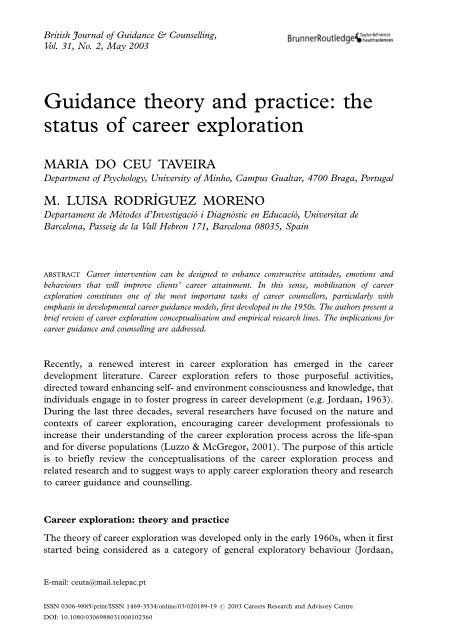
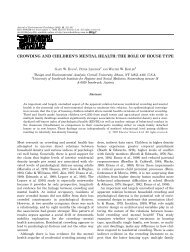
![5 Verben 2 S[1]. 35-44.pdf](https://img.yumpu.com/27096544/1/184x260/5-verben-2-s1-35-44pdf.jpg?quality=85)

